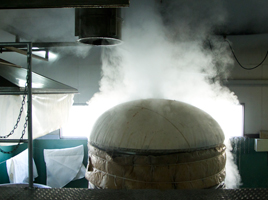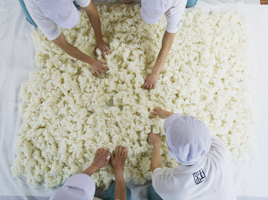Home>English Web Site(About Mori no Kura - a message from us -)>How Our Sake is Made
How Our Sake is Made

At Mori no Kura, we only make junmai varieties, including junmai-shu, junmai ginjo and junmai daiginjo. Here, let us look at how those types are made.
※Displays the description when you click the heading.
- 1. Our rice click
Fukuoka-grown Yamada Nishiki and Yume Ikkon
-
Mori no Kura sake is made using Yamada Nishiki grown in Itoshima and Yume Ikkon grown in Mizuna. Both are sake rice types grown by direct contract with producers. We make frequent trips to the fields where this rice is grown, or to our own rice fields where we experiment with rice, and study the relationship between how the rice is grown and the quality of our sake.
- 2. Milling click
the all-important rice is gently milled by us in-house
-
We then carefully and gently mill the rice ourselves, rather than outsourcing this step, because we can confirm the quality and nature of this year’s rice in that way. Eating rice is milled to 90-92 percent of the original size of the grains. But sake rice at our brewery is milled down to between 40 and 65 percent of the original size of the grains. There are lots of protein and minerals in the outer portion of the rice grains, and if there are too much they will lead to rough flavors in the completed sake. But it is not important to mill all the rice down as much as possible, so we adjust how much the rice is milled based on each situation and each type of sake we brew.

- 3. Washing and soaking the rice click
Delicate work using a stopwatch.
-
The rice is quickly washed to remove the powder clinging to it from the milling process.
The longer the rice soaks, the more water it absorbs, and so the time the rice sits in the water is measured down to the second using a stopwatch. The amount of water it is allowed to absorb depends on the strain of rice, how much it has been milled, and how it is to be used after steaming.

- 4. Steaming the rice click
hard on the outside, soft on the inside
-
The next morning, the carefully washed sake rice is steamed. This will physically break down the starch inside so that enzymes and yeast can work on the rice. Ideally, the rice will be hard and dry on the outside, and soft on the inside.


- 5. Koji making click
the most important step
-
After the rice has cooled down sufficiently and spores of a mold known as koji mold (aspergillus oryzae) is sprinkled on it within a special room. The temperature and moisture are then meticulously controlled through delicate manipulation, and after about 45 to 50 hours, the mold will have grown properly over the surface in into the center of the rice. The objective is for the koji mold to give off enzymes that will later convert the starch in the rice into glucose. This rice with the mold already grown on it is called “koji.” An expression in the world of sake making goes, “first in importance is the koji, second is the yeast starter, and third is the actual fermentation.” This shows how important making koji is, and it calls for great physical and mental effort.


- 6. Creating the yeast starter, or “moto” click
Build a foundation of preparation to increase the yeast
-
Next, a yeast starter that will be the base for the following fermentation is created. Known as the “moto” or the “shubo,” rice, water and koji are mixed into a small tank, and the temperature is carefully controlled so as to create an extremely high population of yeast cells over two weeks. Inside this tank, starch is being converted into sugar at the same time as yeast cells are reproducing, and this balance must be carefully maintained.

- 7. The main fermentation mash click
adding in three stages and temperature control
-
Once the yeast starter is ready, more koji, rice and water are all added three times over four days, gradually increasing the size of the fermenting mash while allowing the yeast population to keep up with things. Within this fermentation mash, starch to sugar conversion and sugar to alcohol conversion are both taking place at the same time. This is called “multiple parallel fermentation,” and is unique to sake, and it allows the fermentation to continue long enough to have a higher alcohol content than other fermented beverages. The mash ferments for about a month, during which time the temperature is carefully controlled to ensure the contents develop properly.


- 8. Pressing click
Pressing the sake to filter out the lees, or “kasu”
-
Once fermentation is complete the mash is filtered to separate the sake from the lees, i.e. the rice solids that remain. There are basically two methods for doing this. One is to put the fermenting mash into long cloth bags and stack these inside a large box into which the lid will be forced. The other is to pump the mash into a large hydraulic machine press.


- 9. Filtering, pasteurization, storage click
the final steps.
-
The completed sake is then filtered to remove small particles and pasteurized to stop the activity of the yeast. These are the final steps of the process. They are deceivingly important, and it goes without saying that they must be performed with great care.
At Mori no Kura, we do ship some freshly pressed sake; however, most of our sake is carefully stored for some time to give it the proper level of maturity before we present it to our customers.

